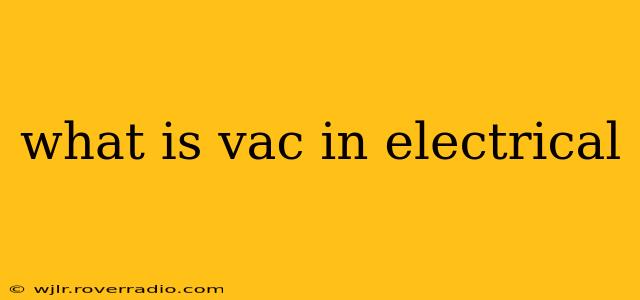VAC, or Volts AC, refers to the voltage of an alternating current (AC) electrical supply. Understanding VAC is crucial for anyone working with electricity, whether it's in a home, industrial setting, or any other application. This article will delve into the meaning of VAC, exploring its significance and answering common questions surrounding this fundamental electrical term.
What Does AC Stand For in Electrical Terms?
AC stands for Alternating Current. Unlike direct current (DC), where electricity flows consistently in one direction, AC electricity periodically reverses its direction. This reversal happens multiple times per second, measured in Hertz (Hz). The standard frequency for household AC power in most parts of the world is either 50 Hz or 60 Hz. The changing direction of the current is what differentiates AC from DC.
What is the Difference Between VAC and VDC?
The key difference lies in the nature of the current:
- VAC (Volts AC): Measures the voltage of alternating current. The voltage fluctuates periodically, usually in a sinusoidal wave pattern.
- VDC (Volts DC): Measures the voltage of direct current. The voltage remains constant, flowing in a single direction.
Different electrical devices require either AC or DC power. For instance, household appliances generally operate on AC power, while many electronic devices use DC power, often obtained by converting AC to DC using a power adapter.
How is VAC Measured?
VAC is measured using a voltmeter. The type of voltmeter needed depends on the voltage level and the type of AC waveform being measured (e.g., true RMS, average). Always exercise caution and follow safety procedures when measuring electrical voltage.
What are Common VAC Voltages?
Common VAC voltages vary depending on the location and application:
- Household power: Common household voltages include 120 VAC (North America) and 230 VAC (Europe and many other parts of the world).
- Industrial applications: Industrial settings might use much higher voltages, ranging from several hundred to thousands of volts.
- Low-voltage applications: Some electronic devices and circuits operate on lower voltages, such as 12 VAC or 24 VAC.
What are the Dangers of High VAC?
High VAC can be extremely dangerous and potentially fatal. Direct contact with high-voltage AC circuits can cause severe electric shock, burns, and even death. Always treat high-voltage AC circuits with extreme caution and follow appropriate safety procedures. Never work with high voltage without proper training and safety equipment.
How is VAC Related to Amps and Watts?
VAC is related to amps (current) and watts (power) through Ohm's law and the power formula:
- Ohm's Law: V = I x R (Voltage = Current x Resistance)
- Power Formula: P = V x I (Power = Voltage x Current)
These formulas allow you to calculate the current or power in an AC circuit, given the voltage and other parameters.
What are Some Examples of Appliances that Use VAC?
Almost all household appliances use VAC, including:
- Refrigerators
- Washing machines
- Televisions
- Lighting
- Computers (though they typically use a DC power supply internally, which converts the AC input)
Understanding VAC is vital for safe and efficient use of electrical devices and systems. If you are unsure about anything related to electrical safety or working with electricity, consult a qualified electrician.
